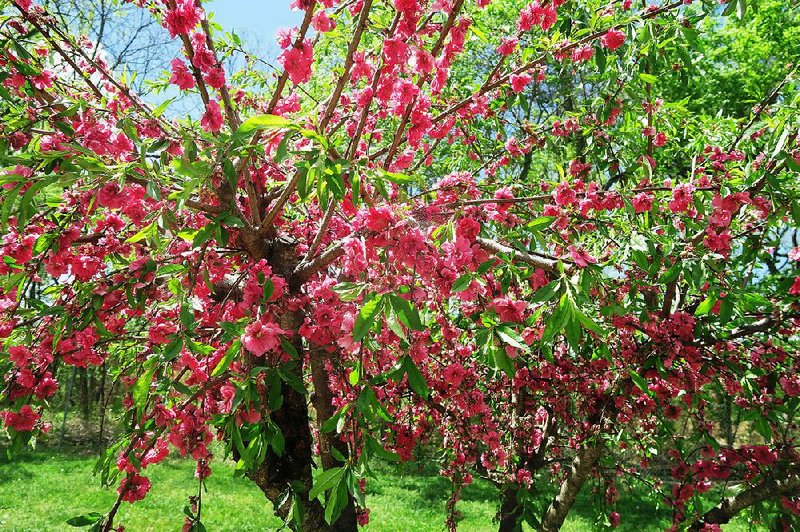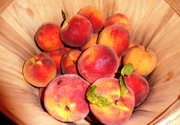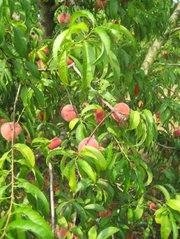JULY
Our weird weather continues. While we have had a taste of heat and humidity, for the most part we are skating through nicely with mild weather, and even with fairly frequent rain. But who knows how long our luck will last?
• Pay attention to the weather. A rain gauge in your yard can save your plants as summer rainfall can be spotty, and you need to know when to water.
• For those with automatic sprinklers, use common sense about how often to water and how long. Daily irrigation is not needed for most plants unless you are growing them in containers in full sun.
• Fertilization is important to keep flowering plants blooming and to help fruiting plants set fruits or vegetables. Make sure there is ample moisture in the soil before you apply, and use a lower dose. High doses of fertilizer on a dry plant that is heat stressed leads to burned foliage. You can always add more fertilizer, but you can't un-damage foliage. Fertilizer is important for annuals and vegetables that are planted in the ground as well as those in containers.
• It has been one of the best years for hydrangeas that we have had in a long time. Not only were our big-leaf hydrangeas covered in blooms ranging from blue and purple to pink, but now the panicle and smooth varieties are blooming. Most hydrangeas love water and shade in the afternoon, but the panicle forms will tolerate full sun. Some varieties are susceptible to cercospora leaf spot, and many plants succumb late in the year. We have started seeing this disease earlier than normal. If your hydrangeas had it in the past but you don't see it now, you can head it off with systemic Immunox or Bayer Advanced Disease Control for Roses, Flowers and Shrubs. Daconil will also work.
• Tomato diseases are rampant. The septoria leaf spot fungus is most active when temperatures are from 68 to 77 degrees, with high humidity and rainfall. So we're seeing it. Infection usually starts on leaves near the ground, after plants begin to set fruit. Many small spots appear on the leaves, and heavy infestation causes them to yellow, die and fall off. Fungicide with chlorothalonil or a copper fungicide can help manage the disease.
• We're also seeing some bacterial tomato diseases, including bacterial wilt. It begins with wilting of younger leaves, followed by a rapid wilting of the entire plant. There will be a dark discoloration and soft rot of the pith (inside of the stem). If you suspect wilt, cut the stem and put it in a glass of water. In 3 to 5 minutes, a milky exudate will begin streaming from the cut end. There is no cure for this disease, so if you find it, destroy the plants and practice crop rotation. Do not use pepper, eggplant or potato plants in the same plot in the rotation, as they are susceptible as well.
• If you have annuals and perennials that set seeds, deadhead them frequently. Deadheading is removing the spent flowers to prevent them from setting seeds. Plants that bloom all season will have more flowers if you remove the spent blooms, since the energy they would expend forming seeds goes back into the plant to set more buds. Many new varieties are self-cleaning, meaning they drop the spent flowers on their own without setting seed heads.
• If you need color in your garden, there is plenty at local nurseries and garden centers. Tropical flowering plants are still arriving, and this is their season -- they love it hot and humid. Water and fertilize weekly and they will bloom nonstop.
• Many summer-blooming perennials are in their prime, from the dinner-plate size blooms on hardy hibiscus, to coneflowers, Shasta daisy, coreopsis, liatris and rudbeckia. Many of these flowers benefit from deadheading.
PEACHES
When a home gardener begins to think about planting a fruit tree, the first thing that comes to mind is a peach tree. Peaches, however, are one of the most difficult fruit trees to grow in Arkansas.
Prone to many diseases that thrive in humid conditions, they require the most intensive spray program of all the fruiting trees to produce good-quality fruits.
Rainy summers are worse for diseases than dry summers. Brown rot, a common fungal disease, can turn pretty fruit into brown mush seemingly overnight if proper spraying is not performed.
All of that being said, peaches are in season now.
There are two distinct types of peaches -- freestone and cling. In cling peaches, the fruit adheres to the seed, while in freestone varieties, the seed pops out fairly easily. Both require regular spraying.
Peaches are self-fruitful, which means you can have peaches with only one tree, as they don't need another variety to aid in pollination. There are early varieties that ripen in late May to early June and late varieties that ripen in late July through early August. Many people feel that the later varieties are of higher quality, but you also have to contend with spray schedules for a much longer time.
If you order a sapling online, make sure the variety you are considering requires more than 750 "chilling hours." Chilling hours are the number of hours a tree experiences between 35 and 55 degrees. If a tree has a low requirement for low chilling hours it can be grown farther south, but it also means it can achieve those chilling hours too early in cooler climates, which results in breaking dormancy and blooming too early to escape damage from a late freeze.
Some good varieties for Arkansas include: early -- "Goldcrest" and "Surecrop," followed by "Redhaven," then "Loring," then "Cresthaven" and ending with "White River" and "Summer Pearl."
Peaches need well-drained soil in full sun. Even without high-quality fruit, they are pretty trees when blooming in the spring.
In my opinion, peach trees take too much effort for the home garden, so I let the growers grow my peaches, which I buy from the farmers markets or a pick-them-yourself farm. But they sure are good.
Janet B. Carson is a horticulture specialist for the University of Arkansas Cooperative Extension Service.
HomeStyle on 07/01/2017



